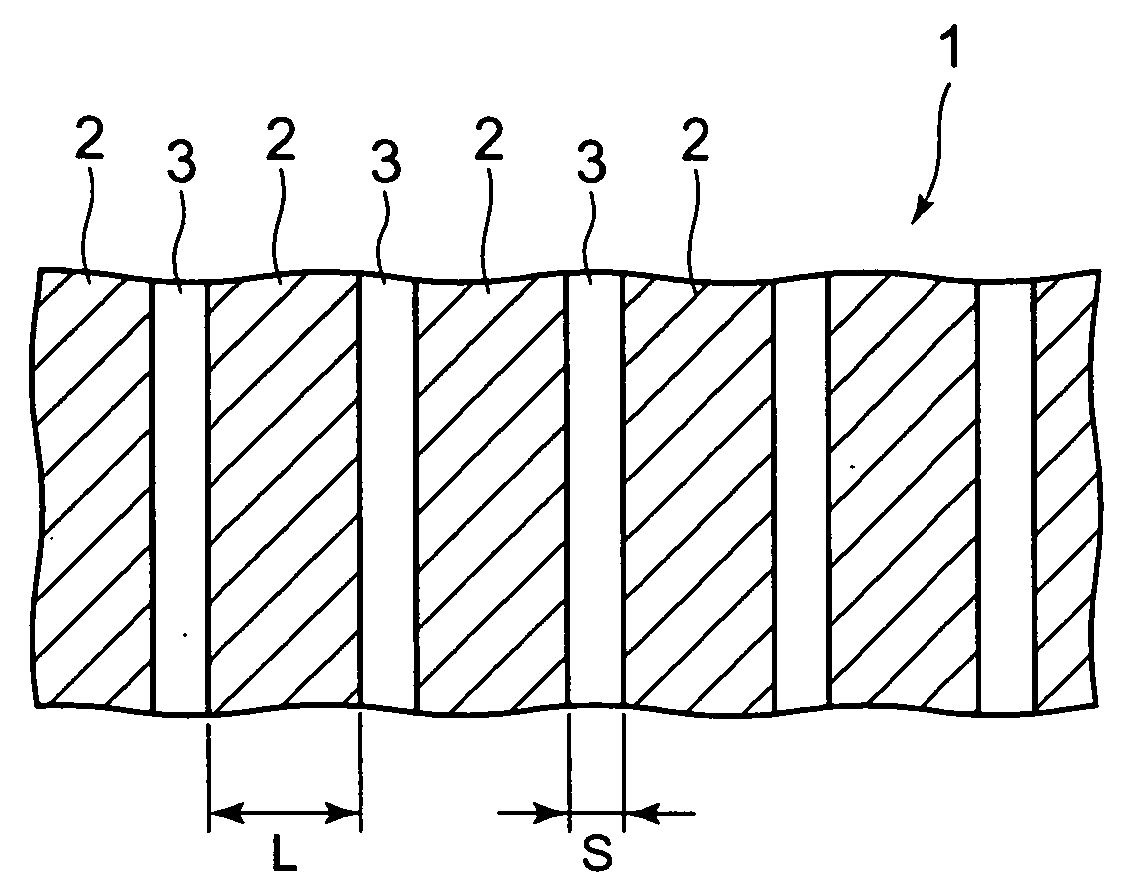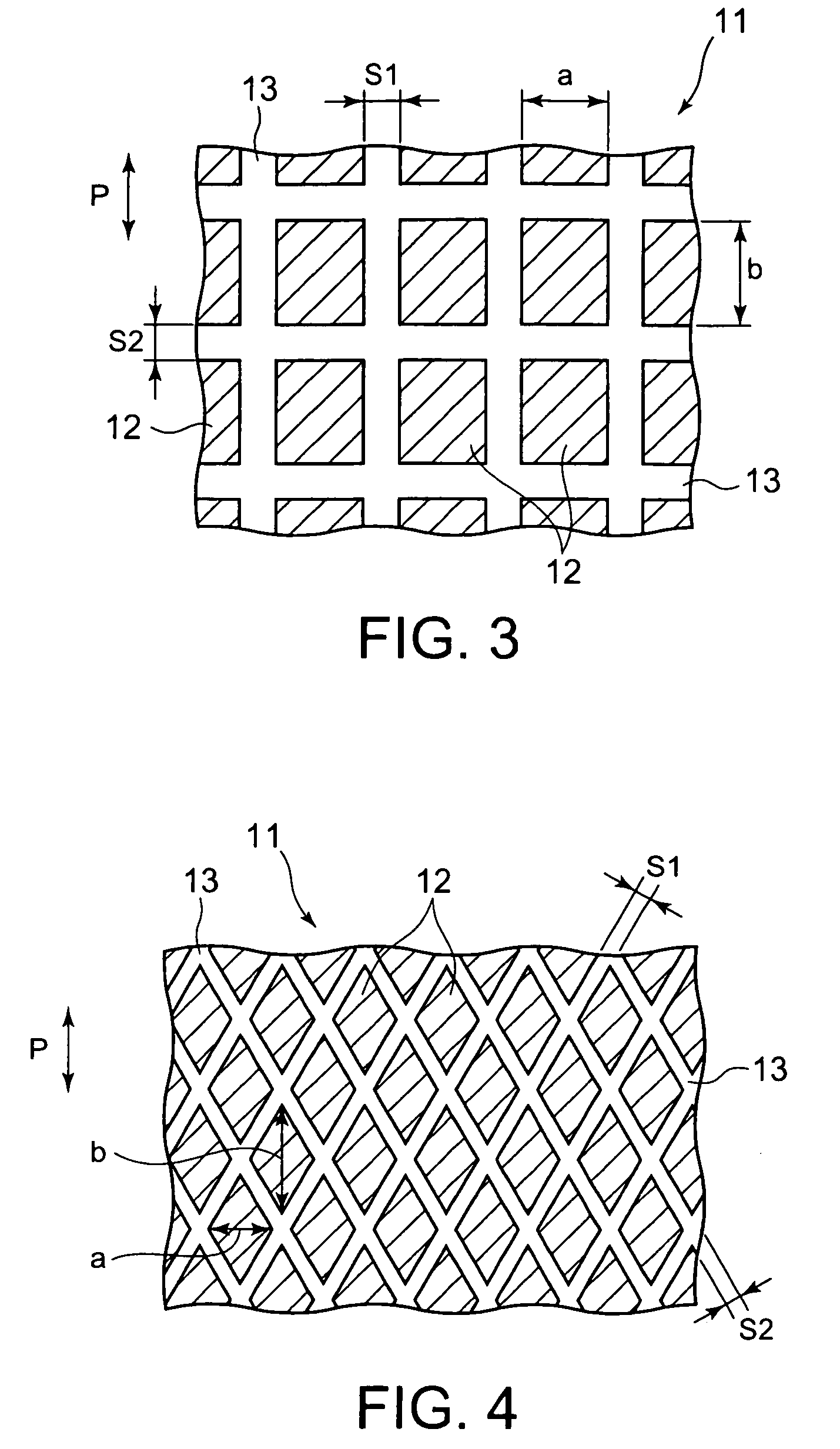Gravure plate, method for forming light-emitting layer or hole-injection layer using the same, and organic light-emitting device
- Summary
- Abstract
- Description
- Claims
- Application Information
AI Technical Summary
Benefits of technology
Problems solved by technology
Method used
Image
Examples
example 1
[0176] Ten different gravure plates (G1-A to G1-J) in the form of sheets, having cells in the shape of stripes (the depth of the cells: 35 μm) extending in the direction of printing (the direction of rotation of the blanket cylinder), were prepared, in which the length L of the cell portions and the length S of the non-cell portions were changed over a range of 10 to 500 μm and a range of 2 to 500 μm, respectively, to vary, as shown in Table 1, the proportion of the length L of the cell portions to the length S of the non-cell portions S, L / S. The effective width of the gravure plates was 50 mm.
[0177] A red-light-emitting-layer-forming ink composition A1 having the following formulation was prepared. The coefficient of viscosity of this ink composition A1 (ink temperature: 23° C.), measured at a shear rate of 100 sec−1 with a viscoelasticity meter Model MCR301 manufactured by Physica Corp. in the steady flow mode, was 80 cP. Further, using a tension meter Model CBVP-Z manufactured ...
example 2
[0194] Nine different gravure plates (G2-A to G2-I) in the form of sheets, having cells in the shape of stripes (the depth of the cells: 35 μm) extending in the direction of printing (the direction of rotation of the blanket cylinder), were prepared, in which the length L of the cell portions and the length S of the non-cell portions were varied as shown in Table 2 so that the proportion of the length L of the cell portions to the length S of the non-cell portions, L / S, fell in the range of 1 to 10. The effective width of the gravure plates was 50 mm.
[0195] Red light-emitting layers and hole-injection layers were formed in the same manner as in Example 1, except that the above-described gravure plates were used instead of the gravure plates used in Example 1.
[0196] Printability at the time the red light-emitting layers were formed by the use of the gravure plates different in both the length L of the cell portions and the length S of the non-cell portions, and printability at the ...
example 3
[0198] Seven different gravure plates (G3-A to G3-G) in the form of sheets, varying in depth as shown in Table 3, having cells in the shape of stripes extending in the direction of printing (the direction of rotation of the blanket cylinder), were prepared, in which the length L of the cell portions and the length S of the non-cell portions S were made 120 μm and 30 μm, respectively (the proportion L / S was 4). The effective width of the gravure plates was 50 mm.
[0199] Red light-emitting layers and hole-injection layers were formed in the same manner as in Example 1, except that the above-described gravure plates were used instead of the gravure plates used in Example 1.
[0200] Printability at the time the red light-emitting layers were formed by the use of the gravure plates different in depth, and printability at the time the hole-injection layers were formed by the use of these gravure plates were evaluated. Further, the percentage of variations in thickness [(maximum thickness−m...
PUM
 Login to View More
Login to View More Abstract
Description
Claims
Application Information
 Login to View More
Login to View More - R&D
- Intellectual Property
- Life Sciences
- Materials
- Tech Scout
- Unparalleled Data Quality
- Higher Quality Content
- 60% Fewer Hallucinations
Browse by: Latest US Patents, China's latest patents, Technical Efficacy Thesaurus, Application Domain, Technology Topic, Popular Technical Reports.
© 2025 PatSnap. All rights reserved.Legal|Privacy policy|Modern Slavery Act Transparency Statement|Sitemap|About US| Contact US: help@patsnap.com



